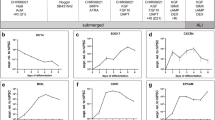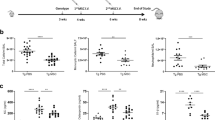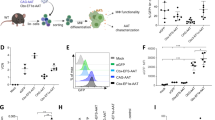Abstract
Background:
Overexpression of connective tissue growth factor (CTGF) in alveolar type II epithelial (AT II) cells disrupts alveolar structure, causes interstitial fibrosis, and upregulates integrin-linked kinase (ILK). Whether CTGF-ILK signaling induces epithelial to mesenchymal transition (EMT) in AT II cells is unknown.
Methods:
Transgenic mice with targeted overexpression of CTGF in AT II cells were generated utilizing the surfactant protein C (SP-C) gene promoter and doxycycline-inducible system. AT II cells were isolated from 4-wk-old CTGF-overexpressing (CTGF+) mice and control littermates, and cultured on Matrigel. Cells were transfected with ILK siRNA, and cell morphology and expression of cell differentiation markers were analyzed.
Results:
The AT II cells from the control lungs grew in clusters and formed alveolar-like cysts and expressed SP-C. In contrast, the cells from CTGF+ lungs were spread and failed to form alveolar-like cysts. These cells expressed higher levels of CTGF, α smooth muscle actin (α-SMA), fibronectin and vimentin, the mesenchymal markers, suggesting EMT-like changes. Transfection with ILK siRNA not only dramatically attenuated ILK expression, but also decreased α-SMA expression as well as reversed cell morphological changes in CTGF+ AT II cells.
Conclusion:
Overexpression of CTGF induces EMT in mouse primary AT II cells and this is mediated by ILK.
Similar content being viewed by others
Log in or create a free account to read this content
Gain free access to this article, as well as selected content from this journal and more on nature.com
or
References
Coalson JJ . Pathology of new bronchopulmonary dysplasia. Semin Neonatol 2003;8:73–81.
Noble PW, Barkauskas CE, Jiang D . Pulmonary fibrosis: patterns and perpetrators. J Clin Invest 2012;122:2756–62.
Scotton CJ, Chambers RC . Molecular targets in pulmonary fibrosis: the myofibroblast in focus. Chest 2007;132:1311–21.
Champam HA . Epithelial-mesenchymal interactions in pulmonary fibrosis. Annu Rev Physiol 2011;73:413–35.
Kage H, Borok Z . EMT and interstitial lung disease: a mysterious relationship. Curr Opin Pulm Med 2012;18:517–23.
Ihn H . Autocrine TGF-beta signaling in the pathogenesis of systemic sclerosis. J Dermatol Sci 2008;49:103–13.
Kulozik M, Hogg A, Lankat-Buttgereit B, Krieg T . Co-localization of transforming growth factor beta 2 with alpha 1(I) procollagen mRNA in tissue sections of patients with systemic sclerosis. J Clin Invest 1990;86:917–22.
Oi M, Yamamoto T, Nishioka K . Increased expression of TGF-beta1 in the sclerotic skin in bleomycin-‘susceptible’ mouse strains. J Med Dent Sci 2004;51:7–17.
Blobe GC, Schiemann WP, Lodish HF . Role of transforming growth factor beta in human disease. N Engl J Med 2000;342:1350–8.
Bonniaud P, Margetts PJ, Kolb M, et al. Progressive transforming growth factor beta1-induced lung fibrosis is blocked by an orally active ALK5 kinase inhibitor. Am J Respir Crit Care Med 2005;171:889–98.
Kolb M, Margetts PJ, Sime PJ, Gauldie J . Proteoglycans decorin and biglycan differentially modulate TGF-beta-mediated fibrotic responses in the lung. Am J Physiol Lung Cell Mol Physiol 2001;280:L1327–34.
Varga J, Pasche B . Transforming growth factor beta as a therapeutic target in systemic sclerosis. Nat Rev Rheumatol 2009;5:200–6.
Perbal B . CCN proteins: multifunctional signalling regulators. Lancet 2004;363:62–4.
de Winter P, Leoni P, Abraham D . Connective tissue growth factor: structure-function relationships of a mosaic, multifunctional protein. Growth Factors 2008;26:80–91.
Grotendorst GR . Connective tissue growth factor: a mediator of TGF-beta action on fibroblasts. Cytokine Growth Factor Rev 1997;8:171–9.
Kothapalli D, Frazier KS, Welply A, Segarini PR, Grotendorst GR . Transforming growth factor beta induces anchorage-independent growth of NRK fibroblasts via a connective tissue growth factor-dependent signaling pathway. Cell Growth Differ 1997;8:61–8.
Garrett Q, Khaw PT, Blalock TD, Schultz GS, Grotendorst GR, Daniels JT . Involvement of CTGF in TGF-beta1-stimulation of myofibroblast differentiation and collagen matrix contraction in the presence of mechanical stress. Invest Ophthalmol Vis Sci 2004;45:1109–16.
Duncan MR, Frazier KS, Abramson S, et al. Connective tissue growth factor mediates transforming growth factor beta-induced collagen synthesis: down-regulation by cAMP. FASEB J 1999;13:1774–86.
Gao R, Brigstock DR . Connective tissue growth factor (CCN2) induces adhesion of rat activated hepatic stellate cells by binding of its C-terminal domain to integrin alpha(v)beta(3) and heparan sulfate proteoglycan. J Biol Chem 2004;279:8848–55.
Heng EC, Huang Y, Black SA Jr, Trackman PC . CCN2, connective tissue growth factor, stimulates collagen deposition by gingival fibroblasts via module 3 and alpha6- and beta1 integrins. J Cell Biochem 2006;98:409–20.
Jedsadayanmata A, Chen CC, Kireeva ML, Lau LF, Lam SC . Activation-dependent adhesion of human platelets to Cyr61 and Fisp12/mouse connective tissue growth factor is mediated through integrin alpha(IIb)beta(3). J Biol Chem 1999;274:24321–7.
Schwartz MA, Ginsberg MH . Networks and crosstalk: integrin signalling spreads. Nat Cell Biol 2002;4:E65–8.
Joshi MB, Ivanov D, Philippova M, Erne P, Resink TJ . Integrin-linked kinase is an essential mediator for T-cadherin-dependent signaling via Akt and GSK3beta in endothelial cells. FASEB J 2007;21:3083–95.
Naska S, Park KJ, Hannigan GE, Dedhar S, Miller FD, Kaplan DR . An essential role for the integrin-linked kinase-glycogen synthase kinase-3 beta pathway during dendrite initiation and growth. J Neurosci 2006;26:13344–56.
Medici D, Nawshad A . Type I collagen promotes epithelial-mesenchymal transition through ILK-dependent activation of NF-kappaB and LEF-1. Matrix Biol 2010;29:161–5.
Fuchs BC, Fujii T, Dorfman JD, et al. Epithelial-to-mesenchymal transition and integrin-linked kinase mediate sensitivity to epidermal growth factor receptor inhibition in human hepatoma cells. Cancer Res 2008;68:2391–9.
Weaver MS, Toida N, Sage EH . Expression of integrin-linked kinase in the murine lens is consistent with its role in epithelial-mesenchymal transition of lens epithelial cells in vitro. Mol Vis 2007;13:707–18.
Sato S, Nagaoka T, Hasegawa M, et al. Serum levels of connective tissue growth factor are elevated in patients with systemic sclerosis: association with extent of skin sclerosis and severity of pulmonary fibrosis. J Rheumatol 2000;27:149–54.
Abraham D . Connective tissue growth factor: growth factor, matricellular organizer, fibrotic biomarker or molecular target for anti-fibrotic therapy in SSc? Rheumatology (Oxford) 2008;47:Suppl 5:v8–9.
Alapati D, Rong M, Chen S, et al. Connective tissue growth factor antibody therapy attenuates hyperoxia-induced lung injury in neonatal rats. Am J Respir Cell Mol Biol 2011;45:1169–77.
Sonnylal S, Shi-Wen X, Leoni P, et al. Selective expression of connective tissue growth factor in fibroblasts in vivo promotes systemic tissue fibrosis. Arthritis Rheum 2010;62:1523–32.
Sonnylal S, Xu S, Jones H, et al. Connective tissue growth factor causes EMT-like cell fate changes in vivo and in vitro. J Cell Sci 2013;126(Pt 10):2164–75.
Chen S, Rong M, Platteau A, et al. CTGF disrupts alveolarization and induces pulmonary hypertension in neonatal mice: implication in the pathogenesis of severe bronchopulmonary dysplasia. Am J Physiol Lung Cell Mol Physiol 2011;300:L330–40.
Liu BC, Li MX, Zhang JD, Liu XC, Zhang XL, Phillips AO . Inhibition of integrin-linked kinase via a siRNA expression plasmid attenuates connective tissue growth factor-induced human proximal tubular epithelial cells to mesenchymal transition. Am J Nephrol 2008;28:143–51.
Ivkovic S, Yoon BS, Popoff SN, et al. Connective tissue growth factor coordinates chondrogenesis and angiogenesis during skeletal development. Development 2003;130:2779–91.
Crosby LM, Waters CM . Epithelial repair mechanisms in the lung. Am J Physiol Lung Cell Mol Physiol 2010;298:L715–31.
Wynn TA . Common and unique mechanisms regulate fibrosis in various fibroproliferative diseases. J Clin Invest 2007;117:524–9.
Yao HW, Xie QM, Chen JQ, Deng YM, Tang HF . TGF-beta1 induces alveolar epithelial to mesenchymal transition in vitro. Life Sci 2004;76:29–37.
Willis BC, Liebler JM, Luby-Phelps K, et al. Induction of epithelial-mesenchymal transition in alveolar epithelial cells by transforming growth factor-beta1: potential role in idiopathic pulmonary fibrosis. Am J Pathol 2005;166:1321–32.
Yu W, Fang X, Ewald A, et al. Formation of cysts by alveolar type II cells in three-dimensional culture reveals a novel mechanism for epithelial morphogenesis. Mol Biol Cell 2007;18:1693–700.
Author information
Authors and Affiliations
Corresponding author
Rights and permissions
About this article
Cite this article
Shafieian, M., Chen, S. & Wu, S. Integrin-linked kinase mediates CTGF-induced epithelial to mesenchymal transition in alveolar type II epithelial cells. Pediatr Res 77, 520–527 (2015). https://doi.org/10.1038/pr.2015.8
Received:
Accepted:
Published:
Issue date:
DOI: https://doi.org/10.1038/pr.2015.8
This article is cited by
-
Amphiregulin induces CCN2 and fibronectin expression by TGF-β through EGFR-dependent pathway in lung epithelial cells
Respiratory Research (2022)
-
The TGFβ/Notch axis facilitates Müller cell-to-epithelial transition to ultimately form a chronic glial scar
Molecular Neurodegeneration (2021)
-
Caffeine modulates glucocorticoid-induced expression of CTGF in lung epithelial cells and fibroblasts
Respiratory Research (2017)
-
Inhibition of β-catenin signaling protects against CTGF-induced alveolar and vascular pathology in neonatal mouse lung
Pediatric Research (2016)



